Blackbird
Goat Whisperer
This is just the way I, personally, make my goat milk soap. There are many ways to make this and many recipes on the web.
This recipe makes about 30 bars.
Goat Milk Soap

Ingredients:
8 oz. Castor oil
8 oz. Cocoa butter
25 oz. Coconut oil
72 oz Palm Kernel oil
8 oz. Olive oil
8 oz. Shea butter
18 oz. 100% Pure Lye (I use a granule form)
40 oz. Frozen or slushy goat milk
Optional essential oils, fragrance, and colorants
Equipment:
2 large stainless steel or non-chipped enamel pans
Rubber spatula or wooden spoon
90-200 F thermometer
Scale or graduated cylinder measurer for weighing materials
Soap molds
Goggles
Chemical resistant rubber gloves
Clothing that does not expose any skin, such as legs, feet, or arms.
Steps:
1. Weigh oils and butters and combine in your large pan.

2. Heat the oils and butters until everything is completely melted. Cool to about 110 degrees. While it is cooling continue onto the other steps.
3. Add the 40 oz. frozen or slushy milk to the other large pan. Fill sink with cold water and ice, submerge pan of milk in water.
4. Put on necessary safety equipment. Lye is corrosive and can cause chemical burns if touched by bare skin.
5. Slowly add the lye to the milk while constantly stirring. It should take a course of twenty minutes to slowly add the 18 oz. of lye. Do not add it all at once, it will heat up too fast and scald the milk if you do. Occasionally check the temperature making sure it does not get above 150 degrees. If the temperature rises too quickly add more cold water around the pan and wait until the temp drops. Try not to breath in the fumes; an open window might be a good idea.
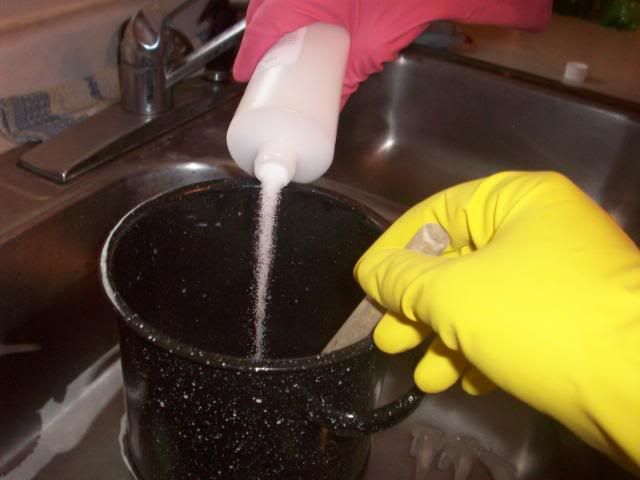
6. Once all of the lye is added let it cool to 110 degrees.
7. Add the lye and milk mixture INTO the oils. Do not reverse this step. Stir while you do this. It is important to have both pans of contents as close to the same temperature as possible. If your lye/milk is 110, but your oils are still too high, try putting the pan of oils into the ice water to cool it down faster.
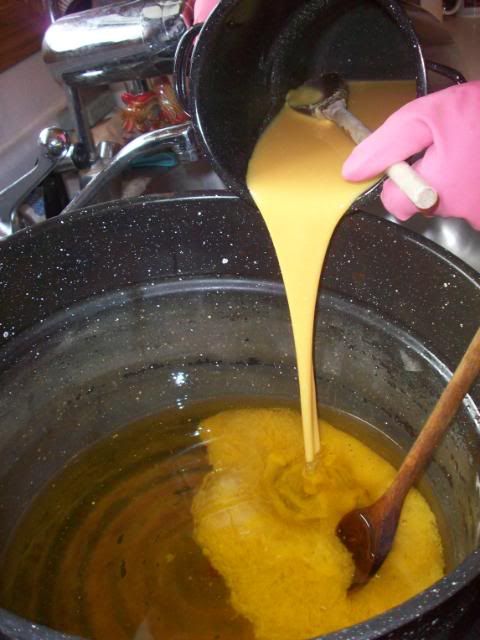
8. If you are adding colorants, essential oils, or fragrances, now is the time.
9. Continue to stir until the mixture thickens into a gel or paste. This process it called tracing. A stick blender is often recommended because tracing can take up to an hour or longer when stirring by hand, depending on the kind of oils. There are different stages of trace but as long as the lye/milk solution is combined well enough with the oils - without separation, it is fine. Generally when a stream of mixture is drizzled on top and remains and holds its shape, you are done with tracing.
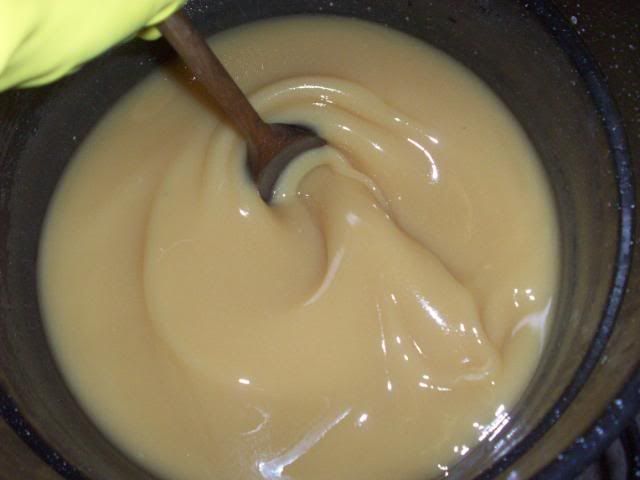
10. Pour the mixture into your soap molds. *The picture below is of a very thin trace, a thicker trace is desirable*

11. After 24 hours the soap can be removed from the molds and cut. Because the recipe uses goat milk, no incubation is needed whereas other non-milk recipes often call for it. Set the bars somewhere dry to cure for four weeks. Curing, or leaving the soap alone to sit basically dissolves the lye over time, lowering the lye content and the Ph level until it is safe.
Properties of Goat Milk Soap: *Note - since writing this I've done more research and not all of the following regarding oil effects are correct; please see this website instead: http://www.summerbeemeadow.com/content/properties-soapmaking-oils*
As well as the oils included, the soap contains goat milk. Goat milk contains lactic acid which helps smooth skin by exfoliation, contains Vitamins A and D, which benefit skin strength and suppleness and has the same Ph level as human skin, thus enhancing it.
Together these ingredients form a very kind, luxurious, and pleasant soap for the body.
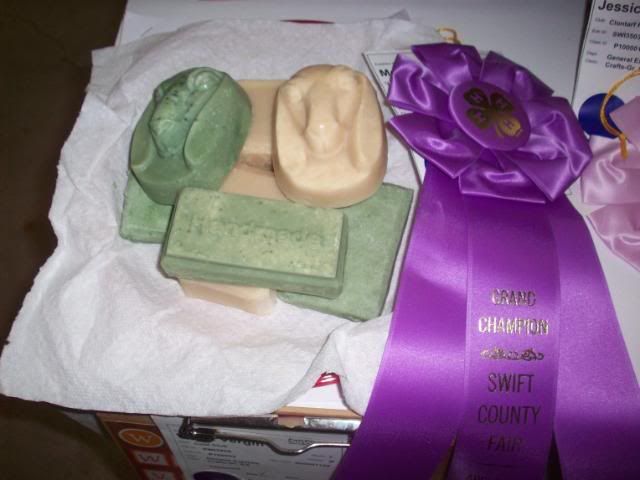
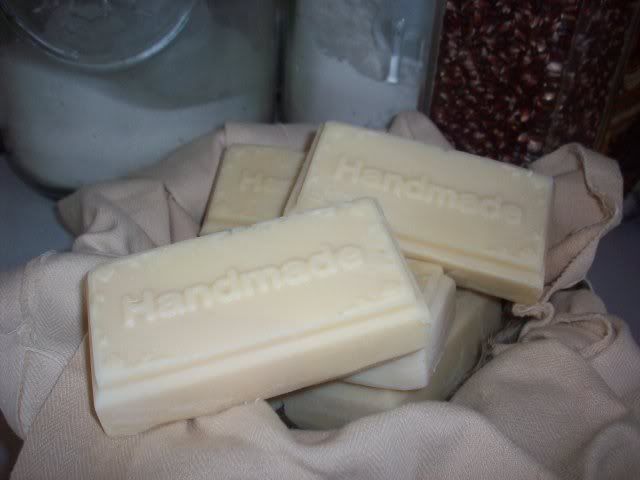
Tips & Hints:
*Lye, or Sodium Hydroxide is a very corrosive solution. It can leave permanent chemical burns and even cause blindness. Proper safety gear and precautions should be taken when handling lye. Common sense, goggles, rubber gloves, long sleeved shirts, and even face masks are recommended.
*White vinegar is recommended to have on hand when handling lye. Vinegar neutralizes the chemicals within lye so that it does not burn. Medical attention may be needed if lye is swallowed or comes in contact with the eyes. The Poison Help Hotline is; 1-800-222-1222. If these instructions frustrate you, the Headache Foundation Hotline is 1-800-843-2256. And finally, if it comes down to it, the National Suicide Prevention Lifeline is 1-800-273-TALK (8255).
*After periodic use when stirring lye, wooden spoons can crack and splinter. If you use wood, make sure it isnt special.
*Equipment that contains metals such as copper and aluminum should not be used as lye can destroy the metal and pollute your soap. Glass should also not be used with lye.
*Equipment used to make soap, such as spoons, pots, etc should not be used for other activities such as cooking in case of residue or seeping of the lye.
*Milk must be very cold, slushy, or frozen when the lye is added or it will scald. You can put your weighed milk into ice cube trays and freeze. Simply put the milk cubes into a bag and crush them before you add the lye.
*Lye sold for cleaning drains should not be used for soap making, as it often contains alum and other impurities and additives. Only use 100% lye.
*Molds can include a variety of things such as Tupperware containers, or other plastic and wooden non-leak containers.
*When finished using supplies, equipment can be rinsed off and put in a dishwasher.
Online Resources and Supply Stores:
http://www.camdengrey.com/
http://www.peakcandle.com/
http://www.biodieselbarn.com/
http://www.brambleberry.com/
http://www.thesage.com/index.html
http://www.newdirectionsaromatics.ca/
http://www.mountainroseherbs.com/index2.html
This recipe makes about 30 bars.
Goat Milk Soap

Ingredients:
8 oz. Castor oil
8 oz. Cocoa butter
25 oz. Coconut oil
72 oz Palm Kernel oil
8 oz. Olive oil
8 oz. Shea butter
18 oz. 100% Pure Lye (I use a granule form)
40 oz. Frozen or slushy goat milk
Optional essential oils, fragrance, and colorants
Equipment:
2 large stainless steel or non-chipped enamel pans
Rubber spatula or wooden spoon
90-200 F thermometer
Scale or graduated cylinder measurer for weighing materials
Soap molds
Goggles
Chemical resistant rubber gloves
Clothing that does not expose any skin, such as legs, feet, or arms.
Steps:
1. Weigh oils and butters and combine in your large pan.

2. Heat the oils and butters until everything is completely melted. Cool to about 110 degrees. While it is cooling continue onto the other steps.
3. Add the 40 oz. frozen or slushy milk to the other large pan. Fill sink with cold water and ice, submerge pan of milk in water.
4. Put on necessary safety equipment. Lye is corrosive and can cause chemical burns if touched by bare skin.
5. Slowly add the lye to the milk while constantly stirring. It should take a course of twenty minutes to slowly add the 18 oz. of lye. Do not add it all at once, it will heat up too fast and scald the milk if you do. Occasionally check the temperature making sure it does not get above 150 degrees. If the temperature rises too quickly add more cold water around the pan and wait until the temp drops. Try not to breath in the fumes; an open window might be a good idea.

6. Once all of the lye is added let it cool to 110 degrees.
7. Add the lye and milk mixture INTO the oils. Do not reverse this step. Stir while you do this. It is important to have both pans of contents as close to the same temperature as possible. If your lye/milk is 110, but your oils are still too high, try putting the pan of oils into the ice water to cool it down faster.

8. If you are adding colorants, essential oils, or fragrances, now is the time.
9. Continue to stir until the mixture thickens into a gel or paste. This process it called tracing. A stick blender is often recommended because tracing can take up to an hour or longer when stirring by hand, depending on the kind of oils. There are different stages of trace but as long as the lye/milk solution is combined well enough with the oils - without separation, it is fine. Generally when a stream of mixture is drizzled on top and remains and holds its shape, you are done with tracing.

10. Pour the mixture into your soap molds. *The picture below is of a very thin trace, a thicker trace is desirable*

11. After 24 hours the soap can be removed from the molds and cut. Because the recipe uses goat milk, no incubation is needed whereas other non-milk recipes often call for it. Set the bars somewhere dry to cure for four weeks. Curing, or leaving the soap alone to sit basically dissolves the lye over time, lowering the lye content and the Ph level until it is safe.
Properties of Goat Milk Soap: *Note - since writing this I've done more research and not all of the following regarding oil effects are correct; please see this website instead: http://www.summerbeemeadow.com/content/properties-soapmaking-oils*
As well as the oils included, the soap contains goat milk. Goat milk contains lactic acid which helps smooth skin by exfoliation, contains Vitamins A and D, which benefit skin strength and suppleness and has the same Ph level as human skin, thus enhancing it.
Together these ingredients form a very kind, luxurious, and pleasant soap for the body.


Tips & Hints:
*Lye, or Sodium Hydroxide is a very corrosive solution. It can leave permanent chemical burns and even cause blindness. Proper safety gear and precautions should be taken when handling lye. Common sense, goggles, rubber gloves, long sleeved shirts, and even face masks are recommended.
*White vinegar is recommended to have on hand when handling lye. Vinegar neutralizes the chemicals within lye so that it does not burn. Medical attention may be needed if lye is swallowed or comes in contact with the eyes. The Poison Help Hotline is; 1-800-222-1222. If these instructions frustrate you, the Headache Foundation Hotline is 1-800-843-2256. And finally, if it comes down to it, the National Suicide Prevention Lifeline is 1-800-273-TALK (8255).
*After periodic use when stirring lye, wooden spoons can crack and splinter. If you use wood, make sure it isnt special.
*Equipment that contains metals such as copper and aluminum should not be used as lye can destroy the metal and pollute your soap. Glass should also not be used with lye.
*Equipment used to make soap, such as spoons, pots, etc should not be used for other activities such as cooking in case of residue or seeping of the lye.
*Milk must be very cold, slushy, or frozen when the lye is added or it will scald. You can put your weighed milk into ice cube trays and freeze. Simply put the milk cubes into a bag and crush them before you add the lye.
*Lye sold for cleaning drains should not be used for soap making, as it often contains alum and other impurities and additives. Only use 100% lye.
*Molds can include a variety of things such as Tupperware containers, or other plastic and wooden non-leak containers.
*When finished using supplies, equipment can be rinsed off and put in a dishwasher.
Online Resources and Supply Stores:
http://www.camdengrey.com/
http://www.peakcandle.com/
http://www.biodieselbarn.com/
http://www.brambleberry.com/
http://www.thesage.com/index.html
http://www.newdirectionsaromatics.ca/
http://www.mountainroseherbs.com/index2.html



 Beautifull!! Now I am wanting to try soap makeing...I think. LOL you really DID make is sound so easy.
Beautifull!! Now I am wanting to try soap makeing...I think. LOL you really DID make is sound so easy.